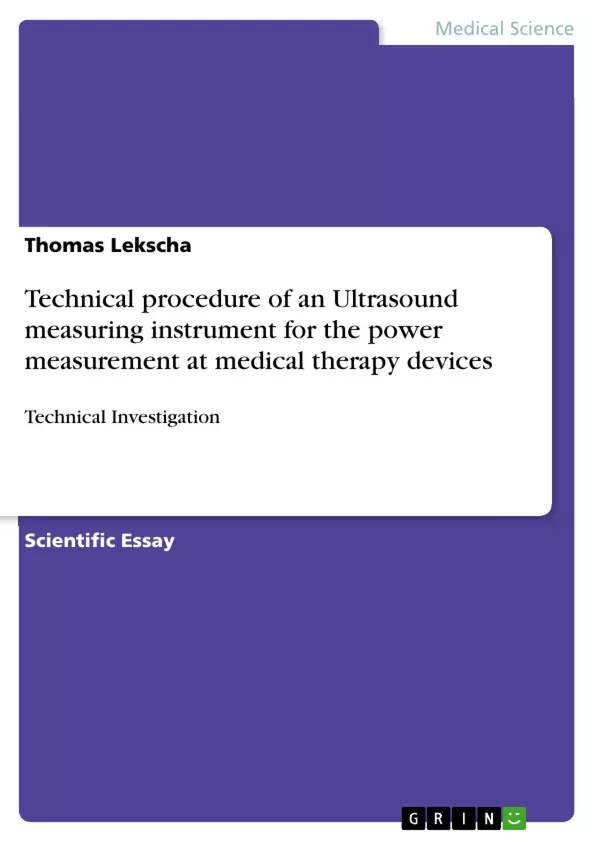This document is concerned with examining whether sound output levels from ultrasonic therapy devices, in particular their ultrasonic transducers, can be determined by means of piezoceramic sensors.
Inhaltsverzeichnis (Table of Contents)
- Introduction
- Basics of Ultrasound
- Selected definitions of terms
- Basics of the Ultrasonic Therapy
- Effects at and in the human tissue
- The effect spectrum and indications
- Basics of the Piezoceramic Sensor
- Historical excursion
- Principles of functioning
- Production and material
- Forms used and their basic oscillation
- Material and Methodology
- Investigation of Ultrasonic Therapy Devices
- Series of Experiments to Find Characteristics
- "Voltage" test setup"
- Series of voltage-measurements
- "Temperature” measurement setup
- Series of temperature measurements
- Thermography of the ultrasonic transducer
- Final Conclusions
- Future prospects of a handheld measuring instrument
Zielsetzung und Themenschwerpunkte (Objectives and Key Themes)
This study aims to investigate the feasibility of using piezoceramic sensors for measuring ultrasonic output levels from ultrasonic therapy devices. The objective is to gather basic information for the development of a handheld measuring instrument that can be used to control these output levels in everyday testing processes. Key themes explored in the document include: * **Basics of ultrasound:** Definitions of terms, characteristics of ultrasonic waves, and their application in medical therapy. * **Piezoceramic sensors:** Their principles of functioning, material properties, and potential for use in ultrasound measurement. * **Ultrasonic therapy devices:** Investigation of their functionalities and the need for reliable output measurement. * **Measurement methodology:** Exploring the potential of piezoceramic sensors as an alternative to the conventional gravimetric method. * **Future prospects:** Considering the potential for a handheld measuring instrument to improve safety and efficiency in the testing of medical devices.Zusammenfassung der Kapitel (Chapter Summaries)
Introduction
This chapter introduces the study's objective, which is to explore the possibility of using piezoceramic sensors to measure ultrasonic output levels from therapy devices. It discusses the current limitations of the conventional gravimetric method and highlights the need for a more convenient and cost-effective approach. The chapter also provides a brief overview of the legal context surrounding the testing of medical devices, emphasizing the importance of regular safety inspections.Basics
This section delves into the fundamental concepts of ultrasound, defining key terms and explaining the characteristics of ultrasonic waves. It discusses the different frequency ranges of sound and their relevance to human hearing. The chapter further explores the application of ultrasound in medical therapy, including its effects on human tissue and its various therapeutic applications.Basics of the Piezoceramic Sensor
This chapter provides an in-depth discussion of piezoceramic sensors, their historical development, and their principles of operation. It explores the materials used in their production and describes the different forms and oscillation modes of these sensors.Material and Methodology
This section describes the methodology employed in the study, focusing on the investigation of ultrasonic therapy devices. It presents the results of the investigation and outlines the series of experiments conducted to characterize the performance of the piezoceramic sensors.Final Conclusions
This chapter concludes the study by summarizing the findings and discussing the potential of using piezoceramic sensors for measuring ultrasonic output levels in therapy devices. It highlights the potential benefits of a handheld measuring instrument for improving the efficiency and safety of medical device testing processes.Schlüsselwörter (Keywords)
The study focuses on key concepts and terms such as ultrasonic therapy devices, ultrasonic transducers, piezoceramic sensors, output measurement, medical device safety, gravimetric method, handheld measuring instrument, and feasibility study.
Ende der Leseprobe aus 62 Seiten
- nach oben
- Arbeit zitieren
- Thomas Lekscha (Autor:in), 2010, Technical procedure of an Ultrasound measuring instrument for the power measurement at medical therapy devices, München, GRIN Verlag, https://www.grin.com/document/150123
Blick ins Buch



